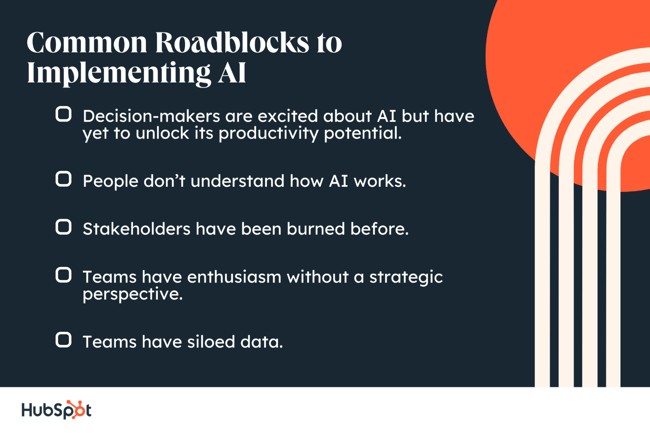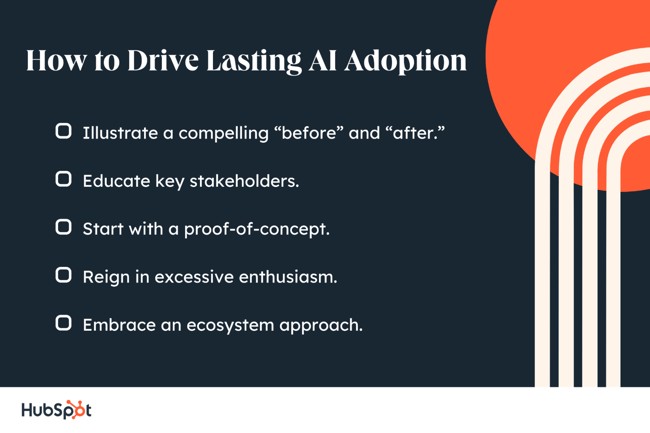Over the last year, I’ve seen AI tools like Claude and ChatGPT transform from cool tech novelties into total game-changers. These technologies are no longer nice-to-haves — they’re critical for any organization looking to stay competitive.
Of course, implementing new AI-powered tools is often easier said than done. In this article, I’ll share some common roadblocks, including a few I’ve encountered as HubSpot’s senior director of global growth. Then, I’ll share some tips and tricks for becoming an AI champion on your marketing team.
By the end of this post, you’ll have the tools you need to drive effective AI adoption across your organization. Let’s dive in.
Table of Contents
- Common Roadblocks to Implementing AI
- How to Drive Lasting AI Adoption
- Become Your Team’s AI Champion
Common Roadblocks to Implementing AI

In my experience, AI implementation requires buy-in at every level — from executives who need to sign off on tools to the individual contributors who actually use AI tools. So, to drive adoption, you need to address a wide range of concerns. Here are the most common I’ve heard.
Decision-makers are excited about AI but have yet to unlock its productivity potential.
Many people may see AI tools as fun new toys but struggle to recognize their potential as useful productivity tools. As a result, I’ve seen teams get excited to use AI on smaller projects but hesitant to invest in a larger-scale implementation.
For example, when I first started learning about AI, I appreciated how it could help me with discrete tasks, like putting together memos, coming up with ideas for experiments, and drafting copy. But, I didn’t truly understand just how powerful AI could be until I started using it for data analysis.
Specifically, after a lengthy homepage optimization project, I used Claude to understand exactly how the shift was impacting our top-of-funnel and down-funnel metrics. Then, I asked it to create two summaries: one for an executive-level audience and one for my team and our other stakeholders.
The entire process took less than two hours (including the time it took for me to fact-check Claude’s conclusions, which I always recommend doing). Without AI, it would’ve taken me days, as well as at least one (human) analyst.
When people see AI as just a fun novelty, they’re unlikely to invest their time and energy into implementation. So, to get people excited about AI’s true potential, it’s important to highlight the incredible, quantifiable impact it can have on your business. Communicate your wins in terms of hours and dollars saved.
People don’t understand how AI works.
Despite the increasing prevalence of AI across a wide range of applications, many people are still unfamiliar with how the technology underlying these tools works. This can make people understandably nervous to rely on AI-powered tools for important business needs.
I’ve noticed that reluctance and AI nerves are especially prevalent when stakeholders are less technologically savvy. Providing some basic AI education can help calm these fears.
Stakeholders have been burned before.
In other cases, I’ve seen teams hesitate to adopt a new AI solution because they’ve been burned in the past by a similar initiative that didn’t go well. Perhaps a product was advertised as a high-powered solution but ended up offering little to the team. Or, maybe, a previous solution was just poorly implemented.
Executives who have seen an AI solution fail before may hesitate to try another one. Champions will need to arm themselves with extra data and a compelling case for why results will be better this time.
Teams have enthusiasm without a strategic perspective.
Of course, resistance to AI isn’t the only factor that can hinder effective implementation. On the other end of the spectrum, I’ve run into managers and executives who are extremely eager to adopt AI. However, they may lack the strategic perspective to identify and move forward with the best approach.
These AI enthusiasts may jump to sign up for the latest, greatest AI tool without stopping to determine whether it’s really a good fit for their organization’s needs. Similarly, they may rush the implementation phase, skipping important planning or communication steps.
While experimenting and moving quickly can lead to AI wins, teams should take the time to build an AI strategy with clearly mapped objectives. Are you trying to save time and/or money? Improve quality? Getting clear on the strategy and “why” from the jump can help you choose the right tools, speed up implementation, and stay aligned with leadership.
Teams have siloed data.
Finally, the challenge I’ve encountered most often when implementing AI across an organization is siloed, disconnected data. After all, your AI recommendations can only be as smart as the data you feed into the system.
If you’re not able to access all the data that’s relevant to the task at hand, then you’ll struggle to get value out of AI tools. That’s also true when accessing that data requires hours of manual work across several inconsistent systems.
How to Drive Lasting AI Adoption

When it comes to implementing AI, there are no one-size-fits-all solutions. Organizations will face different challenges and benefit from different approaches. That said, I’ve found the strategies below an effective route to overcoming the roadblocks.
The end result is lasting AI adoption that helps your marketing team grow.
Illustrate a compelling “before” and “after.”
To get buy-in from key decision-makers, it’s important to move past the theoretical benefits of AI and make the case for your specific project. To tell that story, illustrate a clear, compelling “before” and “after.”
For example, the first big AI initiative that I pitched to my team was for an AI-powered search grader. The project would use OpenAI’s API to tell prospects how well their brand was performing in AI answer engines like ChatGPT, Perplexity, and Gemini.
To get people on board, I didn’t just claim that the tool would be helpful. Instead, I explained how I was currently doing many hours of manual analysis each week to calculate how often HubSpot showed up — and how — in AI engine responses.
I also explained that our prospects and customers were going to face this challenge too (if they weren’t facing it already!). And it worked: Our leadership got it right away, and they quickly greenlit the project.
When it comes to AI, I’ve found that describing how the current system works now and how it could work with the new tool is usually successful. Be sure to outline the ROI and benefits of that future state clearly.
Educate key stakeholders.
AI champions are often educators. After all, people probably won’t get excited about AI if they don’t know how it works — and even if they do, they’re unlikely to be able to use it successfully without at least a basic understanding of the underpinning technology.
With this in mind, whenever I work with colleagues who are less familiar with AI, I’ll start by explaining how the system will work. In some cases, I’ll share the basics of these technologies, including what a large language model (LLM) is and the best practices for using it. Beyond these general explanations of the technology, I’ll also explain how our particular implementation will work.
When acting as an AI educator, be sure to provide the information needed to understand and adopt the idea without drowning people in details.
Start with a proof-of-concept.
Big ideas can be exciting, but I’ve found that starting with a rough proof-of-concept is often the best way to get buy-in and bring an idea to life. A low-risk, minimum viable product (MVP) can help illustrate the benefits of AI without requiring a large up-front investment.
By offering a smaller-scale proof-of-concept, you can help your executive team feel more comfortable greenlighting an AI project. You can also frame your investment as an experiment, rather than a long-term commitment.
Reign in excessive enthusiasm.
On the other hand, when stakeholders are so enthusiastic about AI that they may rush implementation or ignore critical issues, I try to reign them in. Instead of directly squashing their ideas, I ask lots of questions.
For example, I might ask, “Why are you thinking about the project this way?”, “What are we trying to accomplish with AI?”, and “Why is AI valuable for this work?” Ultimately, I usually say, “Now that I better understand what you’re trying to do, can I suggest an alternative?”
Approaching over-enthusiasm with genuine curiosity and a willingness to solve for their end goal can help you steer them in a better direction while preserving the relationship.
Embrace an ecosystem approach.
I’ve learned firsthand how vital it is for marketers to leverage data from across their platforms to drive growth. That means knocking down silos and embracing an ecosystem approach. Making this shift involves engaging internal teams across the organization and external partners.
What does that look like in practice? Let’s start with the internal team. Say that your sales and service teams use Gong to track customer calls. Gong gives you access to extensive call transcripts that are rich in prospect data, offering insights into how you can best position your product.
Marketers can use AI tools to analyze this information and identify potential risks or opportunities for growth. However, this is only possible if teams know what data they’re collecting and share that information freely.
Now, onto the external ecosystem. When you work with partners, not every AI-driven innovation needs to be built by your team. You can work with external partner organizations in your ecosystem that can build solutions for your company.
Let’s use HubSpot as an example. Our Solutions Partners provide services that complement HubSpot’s platform offerings — from implementations to AI-driven analytics to advanced custom integrations. Independent Software Vendor (ISV) Partners build and sell apps that enhance our software’s capabilities, including those featuring AI. The average HubSpot customer uses 9+ apps — leveraging custom tools that help them better serve users in their industries or verticals.
It’s a win-win. Our partners get access to HubSpot customers, an ecosystem that represents a $30 billion opportunity for app and service partners by 2028. Our platform gets enhanced capabilities that can better serve and attract customers — all without any investment dollars from our internal team.
By building out AI capabilities as part of a larger, integrated ecosystem, companies can better serve and grow their customer base. In my experience, that speaks to leadership and drives buy-in.
Become Your Team’s AI Champion
At the end of the day, AI is a tool like any other. For it to make an impact across an organization, it needs a champion to get everyone on board and drive lasting growth. By steering clear of common roadblocks and using the strategies I described above, you’ll be on your way to becoming the AI champion your marketing team needs.
